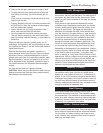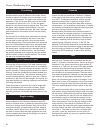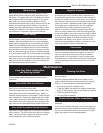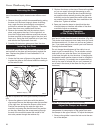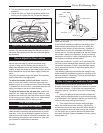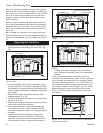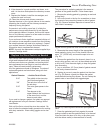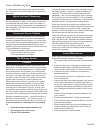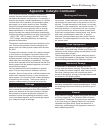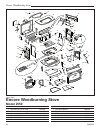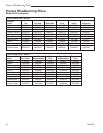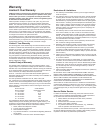
33
Encore Woodburning Stove
2000956
Appendix: Catalytic Combustor
In any chemical reaction, including the combustion
process, there are certain conditions which must be
met before the reaction can take place. For example, a
reaction may require a certain temperature, or a certain
concentration of the reactants (the combustion gases
and oxygen), or a certain amount of time. Catalysts,
though not changed themselves during the reaction,
have the ability to act at a molecular level to change
these requirements. In the Encore’s secondary com-
bustion chamber the catalyst reduces the temperature
at which secondary combustion can start from the 1000
- 1200°F (540 - 650°C) range to the 500 - 600°F (260
- 315°C) range, increasing efficiency, and reducing
creosote and emissions.
The catalytic reaction does have some limitations of its
own. Primary among these is that the reactants (the
gases) come into close physical contact with the cata-
lyst itself.
To ensure the necessary contact, the catalytic element
in your Encore is composed of a ceramic base in the
shape of a honeycomb. Each of the honeycomb’s many
surfaces carries a coating of the catalyst (usually a
noble metal such as platinum or palladium). The large
surface area exposed in this form ensures that the com-
bustion gases have the greatest opportunity to come in
contact with the catalyst.
Loss of catalytic activity will be apparent in several
ways. First you may notice an increase in fuel con-
sumption. Second, there will be a visible increase in the
rate at which creosote builds up in your chimney con-
nector system. You may also notice a heavy discharge
of smoke from the chimney. There are a number of
catalytic problems which can cause loss of activity:
Blockage
While the honeycomb pattern ensures good contact, it
also increases the resistance to flow of the combustion
gases, and, because of the many surfaces, provides
more places for creosote and fly ash to deposit. It is
important to follow the operating instructions in order
to minimize these deposits, and to periodically inspect
your catalyst for signs of blockage.
Masking and Poisoning
While the catalyst itself does not enter into the combus-
tion process, certain elements, such as lead and sulfur,
can attach to the active sites on the surface of the hon-
eycomb. Though the catalyst is still there, it is covered,
or masked, by the contaminant, and cannot function. To
avoid this situation, it is important not to burn anything
in your Encore that is a source of these contaminants.
Particularly avoid painted or treated wood, coal, house-
hold trash, colored papers, metal foils, or plastics.
Chemical chimney cleaners may also contain harmful
elements. The safest approach is to burn only untreat-
ed, natural wood.
Flame Impingement
The catalytic element is not designed for exposure to
direct flame. If you continually overfire your Encore, the
chemistry of the catalyst coating may be altered, inhibit-
ing the combustion process.
Thermal degradation of the ceramic base may also oc-
cur, causing the element to disintegrate. Stay within the
recommended guidelines of the Operation section.
Mechanical Damage
If the element is mishandled, damage may occur.
Always treat the element carefully. Remember the cata-
lyst is made of a ceramic material; treat it as you would
fine china. Hairline cracks will not affect the perfor-
mance of the catalyst, as long as the steel sleeve holds
the element in the proper position.
Peeling
The surface coat may peel if the catalytic element is
frequently subjected to excessive temperatures. Follow
the operating instructions carefully to avoid this type of
damage.
General
Every Vermont Castings’ Encore is equipped with either
a Corning “Long-Life”
®
or a Technical Glass Products
“Honeycomb”
®
combustor. The products are equivalent.
If you must ship your catalytic element for any reason,
remember its fragile nature. Place the element in a
plastic bag, and package it with a generous amount of
shock absorbing material.



